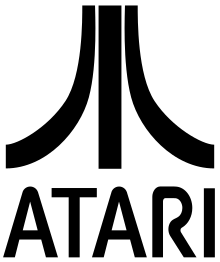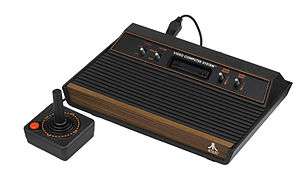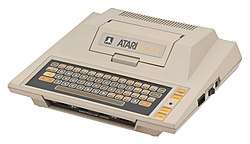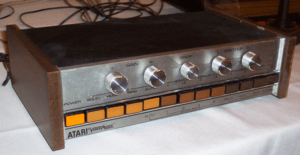Atari, Inc.
Atari, Inc. was an American video game developer and home computer company founded in 1972 by Nolan Bushnell and Ted Dabney.[1] Primarily responsible for the formation of the video arcade and modern video game industry, the company was closed and its assets split in 1984 as a direct result of the video game crash of 1983.
 | |
| Industry | Video games |
|---|---|
| Fate | Split into two companies, non-arcade business[lower-alpha 1] sold to Jack Tramiel, while its arcade division retained by Warner. Atari's telephone brand Ataritel sold to Mitsubishi. |
| Successor | |
| Founded | June 27, 1972 |
| Founders | |
| Defunct | July 1, 1984 |
| Headquarters | |
| Products | |
| Parent | Warner Communications (1976-1984) |
Origins
Syzygy
In 1966, Nolan Bushnell saw Spacewar! for the first time at the University of Utah.[2] By 1968, Bushnell had become an employee of Ampex in San Francisco, and worked alongside Ted Dabney. The two found they had shared interests, including the game Go, Bushnell shared with Dabney his gaming-pizza parlor idea, and had taken him to the computer lab at Stanford Artificial Intelligence Laboratory to see the games on those systems.[3] They jointly developed the concept of using a standalone computer system with a monitor and attaching a coin slot to it to play games on.[3]
Bushnell and Dabney worked with Nutting Associates to manufacture their product. Dabney developed a method of using video circuitry components to mimic functions of a computer for a much cheaper cost and a smaller space. Bushnell and Dabney used this to develop a variation on Spacewar! called Computer Space where the player shot at two orbiting UFOs. Nutting helped to manufacture the fiberglass cabinet. While they were developing this, they took on duties under Nutting to repair pinball machines. Computer Space did not fare well commercially when it was placed in Nutting's customary market, bars; Nutting reported they had produced 2,300 units but only had sold 750.[3] Feeling that the game was simply too complex for the average customer unfamiliar and unsure with the new technology, Bushnell started looking for new ideas.[4] They decided to start a separate venture initially called the Syzygy Game Company, each putting in US$250 of their own funds to support it.[3] They subsequently made sure that Nutting used "Syzygy Engineering" labels on each Computer Space game sold to reflect their work in the game.[3][5]
Founding of Atari

Bushnell began seeking other partners outside of Nutting, and approached pinball game manufacturer Bally Manufacturing, who indicated interest in funding future efforts in arcade games by Bushnell and Dabney if Nutting was not involved.[3] The two quit Nutting and established offices for Syzygy in Sunnyvale; at that point not taking a salary yet since they had no products.[3] Bally then offered them a US$4,000 a month for six months to design a new video game and a new pinball machine.[3] With those funds, they hired Al Alcorn as their first design engineer. Initially wanting to start Syzygy off with a driving game, Bushnell had concerns that it might be too complicated for the young Alcorn's first game.[4] In May 1972, Bushnell had seen a demonstration of the Magnavox Odyssey, which included a tennis game. According to Alcorn, Bushnell decided to have him produce an arcade version of the Odyssey's Tennis game,[6][8] which would go on to be named Pong. Bushnell had Alcorn use Dabney's video circuit concepts to help develop the game, believing it would be a first prototype, but Alcorn's success impressed both Bushnell and Dabney, leading them to believe they had a major success on hand and prepared to offer the game to Bally as part of the contract.[3] In anticipation, Bushnell and Dabney went to incorporate the firm, but found that Syzygy (an astronomical term) already existed in California. Bushnell wrote down several words from Go, eventually choosing atari, a term that in the context of the game means a state where a stone or group of stones is imminently in danger of being taken by one's opponent.[3] Atari was incorporated in the state of California on June 27, 1972.[9]
Bushnell and Dabney offered to license Pong to Bally, but the company had no idea what to do with the game, and did not immediately take the license. Instead, Bushnell and Dabney opted to create a test unit themselves and see how it was received at a local establishment.[3] By August 1972, the first Pong was completed. It consisted of a black and white television from Walgreens, the special game hardware, and a coin mechanism from a laundromat on the side which featured a milk carton inside to catch coins. It was placed in a Sunnyvale tavern by the name of Andy Capp's to test its viability.[10] The Andy Capp test was extremely successful, so the company created twelve more test units, ten which were distributed across other local bars.[3] They found that the machines were averaging around US$400 a week each; in several cases, when bar owners reported that the machines were malfunctioning, Alcorn found that it was due to the coin collector had been overflowing with quarters, shorting out the coin slot mechanism.[3] They reported these numbers to Bally, who still had not decided on taking the license. Bushnell and Dabney realized that they needed to expand on the game but formally needed to get out of their contract with Bally. Bushnell told Bally that they could offer to make another game for them, but only if they rejected Pong; Bally agreed, letting Atari off the hook for the pinball machine design as well.[3]
After talks to release Pong through Nutting and several other companies broke down, Bushnell and Dabney decided to release Pong on their own,[4] and Atari, Inc. was established as a coin-op design and production company.
Early company history
Around 1973, Dabney felt he was being put to the side by Bushnell; Bushnell had left him out of several high-level meetings, assigned him to overseeing the manufacturing process but not the design work, and Dabney discovered Bushnell had patented his video circuit concept without him as an inventor. In March 1973, Dabney formally left Atari, selling his portion of the company for US$250,000.[11][12][13] While Dabney would continue to work for Bushnell on other ventures, including Pizza Time Theaters, he had a falling out with Bushnell and ultimately left the video game industry. Dabney's contributions towards Atari's founding were generally forgotten until 2009, when he gave an in-depth interview with Edge on his role.[3]

In 1973, Atari secretly spawned a "competitor" called Kee Games,[14] headed by Bushnell's next door neighbor Joe Keenan, to circumvent pinball distributors' insistence on exclusive distribution deals; both Atari and Kee could market (virtually) the same game to different distributors, with each getting an "exclusive" deal. Though Kee's relationship to Atari was discovered in 1974, Joe Keenan did such a good job managing the subsidiary that he was promoted to president of Atari that same year.
In 1974, despite Atari's success domestically it was struggling to sell games overseas. In a 2018 interview Alcorn described the situation as "an utter disaster beyond recognition".[15] In the same interview, Bushnell said:
We didn’t realize that Japan was a closed market, and so we were in violation of all kinds of rules and regulations of the Japanese, and they were starting to give us a real bad time.
Ron Gordon was hired as International Marketing Director, and according to Bushnell "fixed all that for us for a huge commission".[15] Bushnell has claimed that deals arranged by Gordon saved Atari.[16]
In 1975, Bushnell started an effort to produce a flexible video game console that was capable of playing all four of Atari's then-current games. Development took place at an offshoot engineering lab, which initially had serious difficulties trying to produce such a machine. However, in early 1976 the now-famous MOS Technology 6502 was released, and for the first time the team had a CPU with both the high-performance and low-cost needed to meet their needs. The result was the Atari 2600, released in October 1977 as the "Video Computer System", one of the most successful consoles in history.
As a subsidiary of Warner Communications
Bushnell knew he had another potential hit on his hands, but bringing the machine to market would be extremely expensive. In 1976 Bushnell sold Atari to Warner Communications for $28 million,[17] using part of the money to buy the Folgers Mansion. He departed from the division in 1979.

A project to design a successor to the 2600 started as soon as the system shipped. The original development team estimated the 2600 had a lifespan of about three years, and decided to build the most powerful machine they could given that time frame. By the middle of the effort's time-frame the home computer revolution was taking off, so the new machines were adapted with the addition of a keyboard and various inputs to produce the Atari 800, and its smaller cousin, the 400. Although a variety of issues made them less attractive than the Apple II for some users, the new machines had some level of success when they finally became available in quantity in 1980.
While part of Warner, Atari achieved its greatest success, selling millions of 2600s and computers. At its peak, Atari accounted for a third of Warner's annual income and was the fastest-growing company in the history of the United States at the time.
Although the 2600 had garnered the lion's share of the home video game market, it experienced its first stiff competition in 1980 from Mattel's Intellivision, which featured ads touting its superior graphics capabilities relative to the 2600. Still, the 2600 remained the industry standard-bearer, because of its market superiority, and because of Atari featuring (by far) the greatest variety of game titles available.
However, Atari ran into problems in the early 1980s. Its home computer, video game console, and arcade divisions operated independently of one another and rarely cooperated.[18] Having grown to exceed the arcade division's sales, the game division viewed computers as a threat,[19] but by 1983 the computer division was losing a price war with Commodore International.[20] The company had a poor reputation in the industry. One dealer told InfoWorld in early 1984 that "It has totally ruined my business ... Atari has ruined all the independents." A non-Atari executive stated:[21]
There were so many screaming, shouting, threatening dialogues, it's unbelievable that any company in America could conduct itself the way Atari conducted itself. Atari used threats, intimidation and bullying. It's incredible that anything could be accomplished. Many people left Atari. There was incredible belittling and humiliation of people. We'll never do business with them again.
Stating that "Atari has never made a dime in microcomputers", John J. Anderson wrote in early 1984:[19]
Many of the people I spoke to at Atari between 1980 and 1983 had little or no idea what the products they were selling were all about, or who if anyone would care. In one case, we were fed mis- and disinformation on a frighteningly regular basis, from a highly-placed someone supposedly in charge of all publicity concerning the computer systems. And chilling as the individual happenstance was, it seems to have been endemic at Atari at the time.
Because of fierce competition and price wars in the game console and home computer markets, Atari was never able to duplicate the success of the 2600.
- In 1982, Atari released disappointing versions of two very publicized games, Pac-Man and E.T. the Extra-Terrestrial, causing inventory to rise and prices to fall. In 1983, in response to a large number of returned orders from distributors, Atari buried 700,000 unsold game cartridges[22] (partly consisting of those same two titles, Pac-Man and E.T.) in a New Mexico desert landfill.
- Popular games from third-party developers such as Activision, Imagic, and Parker Brothers also hurt Atari, reducing its share of the cartridge-game market from 75% in 1981 to less than 40% in 1982.[23]
- In 1983, Atari CEO Ray Kassar was prosecuted for insider trading related to sales of Atari stock minutes before the disappointing earnings announcement in December 1982. He settled with the Securities and Exchange Commission for $81,875, neither admitting or denying the charges.[24]
- The Atari 5200 game console, released as a next-generation follow up to the 2600, was based on the Atari 800 computer (but intentionally incompatible with Atari 800 software),[19] and its sales never met the company's expectations.
These problems were followed by the video game crash of 1983, which caused losses that totaled more than $500 million. Warner's stock price slid from $60 to $20, and the company began searching for a buyer for Atari.[25] When Texas Instruments exited the home-computer market in November 1983 because of the price war with Commodore, many believed that Atari would be next.[21][20] Its Atarisoft games for rival computers sold well,[26] and a rumor stated that Atari planned to discontinue hardware and only sell software.[19]
Atari was still the number one console maker in every market except Japan. Nintendo, a Japanese video game company, planned to release its first programmable video game console, the Famicom (later known to the rest of the world as the NES), in 1983. Looking to sell the console in international markets, Nintendo offered a licensing deal whereby Atari would build and sell the system, paying Nintendo a royalty. The deal was in the works throughout 1983,[27] and the two companies tentatively decided to sign the agreement at the June 1983 CES. However, Coleco demonstrated its new Adam computer with Nintendo's Donkey Kong. Kassar was furious, as Atari owned the rights to publish Donkey Kong for computers, which he accused Nintendo of violating. Nintendo, in turn, criticized Coleco, which only owned the console rights to the game.[28] Coleco had legal grounds to challenge the claim though since Atari had only purchased the floppy disk rights to the game, while the Adam version was cartridge-based.[29] Ray Kassar was soon forced to leave Atari, executives involved in the Famicom deal were forced to start over again, and the deal failed.
Splitting of properties
James J. Morgan was appointed as Kassar's replacement on Labor Day 1983.[21] Stating "one company can't have seven presidents", he stated a goal of more closely integrating the company's divisions to end "the fiefdoms and the politics and all the things that caused the problems".[18] Morgan had less than a year to try to fix the company's problems before he too was gone. In July 1984, Warner sold the home computing and game console divisions of Atari to Jack Tramiel, the recently ousted founder of Commodore, under the name Atari Corporation for $240 million in stocks under the new company. Warner retained the arcade division, continuing it under the name Atari Games and eventually selling it to Namco in 1985. Warner also sold Ataritel to Mitsubishi.
Headquarters
Atari was headquartered in Sunnyvale, California, United States, with a number of locations in Moffett Park were a number of buildings were used by Atari, Inc., the buildings that Atari once used were sold to different companies, or left abandoned.
List of hardware products

- Home Pong (1975)
- Atari Video Music (1976)
- Stunt Cycle (1977)
- Video Pinball (1977)
- Atari 2600 (1977)
- Atari 8-bit family (1979)
- Atari 2700 (cancelled)
- Atari Cosmos (cancelled)
- Atari 5200 (1982)
Arcade games developed by Atari, Inc.
- Video games
- Anti-Aircraft
- Asteroids
- Asteroids Deluxe
- Atari Baseball
- Atari Basketball
- Atari Football
- Atari Soccer
- Avalanche
- Battlezone
- Black Widow
- Breakout
- Canyon Bomber
- Centipede
- Cloak & Dagger
- Cops N Robbers
- Crash 'N Score
- Crystal Castles
- Destroyer
- Dominos
- Drag Race
- Fire Truck
- Firefox
- Flyball
- Food Fight
- Goal IV
- Gotcha
- Gran Trak 10
- Gran Trak 20
- Gravitar
- Hi-way
- I, Robot
- Indy 4
- Indy 800
- Jet Fighter
- LeMans
- Liberator
- Lunar Lander
- Major Havoc
- Millipede
- Missile Command
- Monte Carlo
- Night Driver
- Orbit
- Outlaw
- Pin-Pong
- Pong
- Pong Doubles
- Pool Shark
- Pursuit
- Quadrapong
- Quantum
- Quiz Show
- Qwak!
- Rebound
- Red Baron
- Return of the Jedi[30]
- Shark Jaws
- Sky Diver
- Sky Raider
- Space Duel
- Space Race
- Sprint 1
- Sprint 2
- Sprint 4
- Sprint 8
- Star Wars
- Starship 1
- Steeplechase
- Stunt Cycle
- Subs
- Super Breakout
- Super Bug
- Super Pong
- Tank
- Tank II
- Tank 8
- Tempest
- Tournament Table
- Triple Hunt
- Tunnel Hunt
- Ultra Tank
- Video Pinball
- Warlords
- Pinball
- Airborne Avenger
- The Atarians
- Hercules
- Middle Earth
- Road Runner
- Space Riders
- Superman
- Time 2000
- Unreleased prototypes
- Akka Arrh
- Atari Mini Golf
- Cannonball
- Cloud 9
- Firebeast
- Maze Invaders
- Missile Command 2
- Runaway
- Sebring
- Solar War
- Wolf Pack
In media
Atari ads are featured prominently in the cult movie Blade Runner and its sequel Blade Runner 2049.
Notes
- Including the Atari brand name. Atari Games stopped using the Atari brand after Atari Corporation acquired by Hasbro Interactive.
References
- "Atari". Giant Bomb. July 6, 2013. Retrieved October 2, 2017.
- Isaacson, Walter (October 7, 2014). "The Birth of Pong". Slate. ISSN 1091-2339. Retrieved December 8, 2017.
- Herman, Leonard (April 2009). "The Untold Atari Story". Edge. Vol. 200. pp. 94–99.
- Pescovitz, David (June 12, 1999). "The adventures of King Pong". Salon. Archived from the original on March 7, 2008.
- Vendel, Curt. "ATARI Coin-Op/Arcade Systems 1970 - 1974". Archived from the original on December 9, 2012. Retrieved May 18, 2008.
- Shea, Cam. "Al Alcorn Interview". Retrieved September 11, 2008.
- "Videogames Turn 40 Years Old". 1up. Archived from the original on May 22, 2016.
- California Secretary of State - California Business Search - Corporation Search Results
- Retro gamer issue 83. In the chair with Allan Alcorn
- Berlin, Leslie (November 11, 2017). "The Inside Story of Pong and the Early Days of Atari". Wired. Retrieved May 26, 2018.
- Goldberg, Marty; Vendel, Curt (2012). Atari Inc: Business is Fun. Sygyzy Press. pp. 93–96. ISBN 0985597402.
- Bowles, Nellie (May 31, 2018). "Ted Dabney, a Founder of Atari and a Creator of Pong, Dies at 81". The New York Times. Retrieved June 1, 2018.
- "Atari's Forgotten Arcade Classics". Rolling Stone. Retrieved December 8, 2017.
- "Atari's Hard-Partying Origin Story: An Oral History".
- "Marin investor bets on an impulse - SFGate".
- "What the Hell has Nolan Bushnell Started?". Next Generation. Imagine Media (4): 6–11. April 1995.
- "James Morgan Speaks Out". InfoWorld. February 27, 1984. pp. 106–107. Retrieved January 18, 2015.
- Anderson, John J. (March 1984). "Atari". Creative Computing. p. 51. Retrieved February 6, 2015.
- Cook, Karen (March 6, 1984). "Jr. Sneaks PC into Home". PC Magazine. p. 35. Retrieved October 24, 2013.
- Mace, Scott (February 27, 1984). "Can Atari Bounce Back?". InfoWorld. p. 100. Retrieved January 18, 2015.
- "Five Million E.T. Pieces". snopes.com. Retrieved May 26, 2014.
- Rosenberg, Ron (December 11, 1982). "Competitors Claim Role in Warner Setback". The Boston Globe. p. 1. Retrieved March 6, 2012.
- Cohen, Scott (1984). Zap: The Rise and Fall of Atari. McGraw-Hill. pp. 125–126. ISBN 0070115435.
- David E. Sanger (July 3, 1984). "Warner Sells Atari to Tramiel". The New York Times.
- Mace, Scott (April 9, 1984). "Atarisoft vs. Commodore". InfoWorld. p. 50. Retrieved February 4, 2015.
- Teiser, Don (June 14, 1983). "Atari - Nintendo 1983 Deal - Interoffice Memo". Archived from the original on December 16, 2012. Retrieved November 23, 2006.
- NES 20th Anniversary! - Classic Gaming Archived February 6, 2009, at the Wayback Machine
- Kent, Steven (2001) [2001]. "We Tried to Keep from Laughing". The Ultimate History of Video Games. Roseville, California: Prima Publishing. pp. 283–285. ISBN 0-7615-3643-4.
Yamauchi demanded that Coleco refrain from showing or selling Donkey Kong on the Adam Computer, and Greenberg backed off, though he had legal grounds to challenge that demand. Atari had purchased only the floppy disk license, the Adam version of Donkey Kong was cartridge-based.
- Per game, game operators manual, flyer, and US copyright database
Further reading
- Atari Inc. - Business is Fun, by Curt Vendel, Marty Goldberg (2012) ISBN 0985597402
External links
- The Atari History Museum - Atari historical archive site.
- Atari Times, supporting all Atari consoles.
- AtariAge.com
- Atari entry at MobyGames
- Atari Gaming Headquarters - Atari historical archive site.
- Atari On Film - List of Atari products in films.
- The Dot Eaters - Comprehensive history of videogames, extensive info on Atari offerings and history
- History of Atari from 1978 to 1981
- A History of Syzygy / Atari / Atari Games / Atari Holdings
- Nob6.com